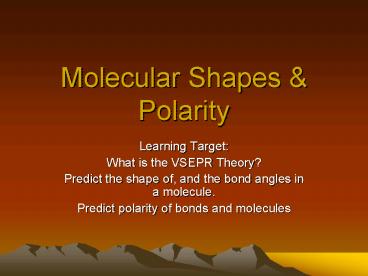Molecular Shapes - PowerPoint PPT Presentation
1 / 17
Title:
Molecular Shapes
Description:
Used for predicting the shape of the molecule, since shape ... Trigonal Planar. Triangular and flat molecule. Three atoms are attached to the central atom. ... – PowerPoint PPT presentation
Number of Views:57
Avg rating:3.0/5.0
Title: Molecular Shapes
1
Molecular Shapes Polarity
- Learning Target
- What is the VSEPR Theory?
- Predict the shape of, and the bond angles in a
molecule. - Predict polarity of bonds and molecules
2
VSEPR Theory
- Valence Shell Electron Pair Repulsion
- Used for predicting the shape of the molecule,
since shape determines the physical and chemical
properties of a molecule. - Model based on an arrangement that minimizes the
replusion of shared and unshared electron pairs
around the central atom.
3
- Molecular Geometry (three dimensional structure)
depends on the nature of the central atom the
bonding electrons and the lone pairs around it. - Bonding pairs electrons that participate in bond
formation (electrons that are shared) - Lone pairs electrons that dont participate in
bond formation. (also called unshared pairs)
4
Linear
- Atoms are arranged in a straight line.
- Bond angle 180
- Ex HCl, CO2
5
Trigonal Planar
- Triangular and flat molecule
- Three atoms are attached to the central atom.
- No lone pairs on the central atom
- Bond angle 120
- Ex HCHO
6
Tetrahedral
- Four atoms are attached to the central atom.
- Bond angle 109.5
- Ex CH4, CCl4
7
Pyramidal
- Three atoms attached to the central atom.
- One lone pair on the central atom
- Bond angle 107
- Ex NH3
8
Bent
- Usually two atoms attached to the central atom.
- Two lone pairs on the central atom
- Bond angle 105
- Ex H2O
9
Assessment
- Use molecular geometry to predict the shape of
the following molecules (Hint You have to draw
the structual formula in order to predict) - HI
- Linear
- 2. CBr4
- Tetrahedral
- 3. H2S
- Bent
- PCl3
- Pyramidal
10
Electronegativity
- The ability of the atoms to attract electrons in
a chemical bond. - In a chemical bond when one atoms in more
electronegative than the other, it has a tendency
to pull electrons towards itself. - Hence, the more electronegative atom becomes
slightly negative, while the other atom becomes
slightly positive creating a dipole.
11
This unequal sharing of electrons results in a
polar covalent bond
12
Electronegativity Bond character
13
Example
- Find the electronegative different between the
HO bond, and predict its bond type. - Answer
- Electronegativity for O 3.44
- Electronegativity for H 2.20
- Difference (3.44 2.20) 1.24
- EN difference 1.24, hence polar covalent
14
Molecule Polarity
- Depends on the shape of the molecule, and bond
polarity or dipole moment. - Dipole moment direction of a polar bond in a
molecule.
15
Nonpolar molecules
- If a bond is nonpolar, the entire molecule
becomes nonpolar. - Ex Cl2
16
- If bonds are polar, but the dipole moments are
symmetrical and they cancel out, the molecule
becomes nonpolar. - Ex CO2, CCl4
17
Polar molecules
- Bonds are polar, but molecule is asymetrical
- Ex H2O
- Polar bonds in symmetrical molecules, but unequal
dipole moment (does not cancel out) - Ex CH3Cl































